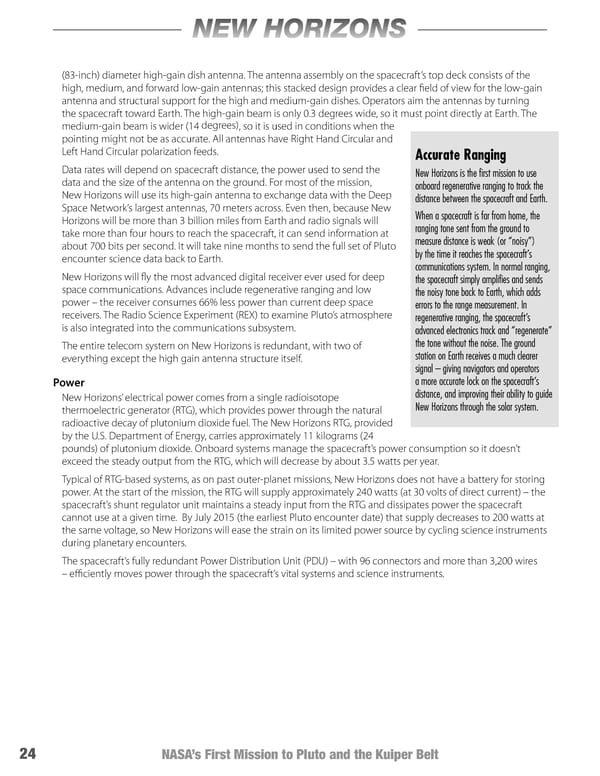NEW HORIZONS (83-inch) diameter high-gain dish antenna. The antenna assembly on the spacecraft’s top deck consists of the high, medium, and forward low-gain antennas; this stacked design provides a clear field of view for the low-gain antenna and structural support for the high and medium-gain dishes. Operators aim the antennas by turning the spacecraft toward Earth. The high-gain beam is only 0.3 degrees wide, so it must point directly at Earth. The degrees) medium-gain beam is wider (14 , so it is used in conditions when the pointing might not be as accurate. All antennas have Right Hand Circular and Left Hand Circular polarization feeds. Accurate Ranging Data rates will depend on spacecraft distance, the power used to send the New Horizons is the first mission to use data and the size of the antenna on the ground. For most of the mission, onboard regenerative ranging to track the New Horizons will use its high-gain antenna to exchange data with the Deep distance between the spacecraft and Earth. Space Network’s largest antennas, 70 meters across. Even then, because New When a spacecraft is far from home, the Horizons will be more than 3 billion miles from Earth and radio signals will ranging tone sent from the ground to take more than four hours to reach the spacecraft, it can send information at measure distance is weak (or “noisy”) about 700 bits per second. It will take nine months to send the full set of Pluto by the time it reaches the spacecraft’s encounter science data back to Earth. communications system. In normal ranging, New Horizons will fly the most advanced digital receiver ever used for deep the spacecraft simply amplifies and sends space communications. Advances include regenerative ranging and low the noisy tone back to Earth, which adds power – the receiver consumes 66% less power than current deep space errors to the range measurement. In receivers. The Radio Science Experiment (REX) to examine Pluto’s atmosphere regenerative ranging, the spacecraft’s is also integrated into the communications subsystem. advanced electronics track and “regenerate” The entire telecom system on New Horizons is redundant, with two of the tone without the noise. The ground everything except the high gain antenna structure itself. station on Earth receives a much clearer signal – giving navigators and operators Power a more accurate lock on the spacecraft’s New Horizons’ electrical power comes from a single radioisotope distance, and improving their ability to guide thermoelectric generator (RTG), which provides power through the natural New Horizons through the solar system. radioactive decay of plutonium dioxide fuel. The New Horizons RTG, provided by the U.S. Department of Energy, carries approximately 11 kilograms (24 pounds) of plutonium dioxide. Onboard systems manage the spacecraft’s power consumption so it doesn’t exceed the steady output from the RTG, which will decrease by about 3.5 watts per year. Typical of RTG-based systems, as on past outer-planet missions, New Horizons does not have a battery for storing power. At the start of the mission, the RTG will supply approximately 240 watts (at 30 volts of direct current) – the spacecraft’s shunt regulator unit maintains a steady input from the RTG and dissipates power the spacecraft cannot use at a given time. By July 2015 (the earliest Pluto encounter date) that supply decreases to 200 watts at the same voltage, so New Horizons will ease the strain on its limited power source by cycling science instruments during planetary encounters. The spacecraft’s fully redundant Power Distribution Unit (PDU) – with 96 connectors and more than 3,200 wires – efficiently moves power through the spacecraft’s vital systems and science instruments. 24 NASA’s First Mission to Pluto and the Kuiper Belt
 New Horizons Page 32 Page 34
New Horizons Page 32 Page 34